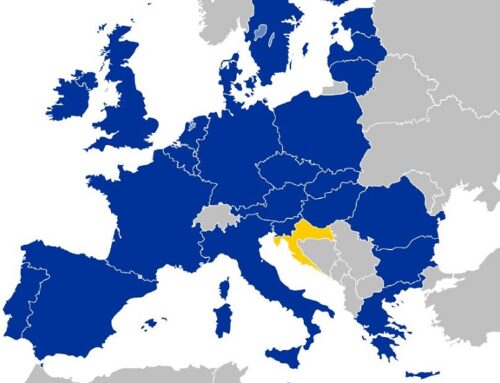Ministry of foreign affairs is one of the most important ministries in every government. It becomes increasingly important in times when a country faces major changes in it’s internal and international affairs. This is exactly the case of some post-soviet countries such as Visegrád group members or Romania. During last 30 years they had to re-establish their foreign policy numerous times and to find their place in the new world order. In this article we examine the Foreign Affairs ministries of the countries named above, trying to understand their similarities and differences in terms of policy priorities, level of consistency and organizational structure.
First of all, let’s take a look at the organizational structure. Generally the Foreign Ministries of the countries are similar in terms of department’s distribution: there are areal departments, responsible for policy in one specific region (for example, Americas Department) and functional departments, responsible for specific “central” functions (such as Human Resources Department) Areal departments are almost similar in most of the countries (due to their geographical similarity) while functional are more diverse[1][2][3][4]. It is worth mentioning that among these countries Slovakia definitely has the biggest number of functional Departments connected with EU activities, which reflects the fact that Slovak foreign policy has been more consistently west-oriented since Slovakia joined the EU than the policy of other states that we compare. Slovak ministry also has more functional Departments connected with 21st century foreign policy specificities, such as Department of Electronization Services and Processes. Finally, it’s worth mentioning that Romanian’s Foreign Ministry structure substantially differs from the others, as it has no expressed areal structure, while it has departments devoted to some specific Romanian priorities, for example, Department for Relations with the Eastern Neighbourhood.
To better understand the specificities of the ministries, we need to take a look at how they crafted policy over time. At the beginning of 1990s Czechoslovakia, Hungary, Poland and Romania had to determine their future position in the global structure after the dissolution of the Soviet Block. One of the main tasks was to choose the pattern of future security system, as after the dissolution of Warsaw Pact a security vacuum occurred in the region. Eventually all the states opted for the Western path (joining NATO and the EU) instead of finding a way to retain neutrality. However, even though ultimate goals of the states were common, their path to NATO and EU was influenced significantly by the traditions and the state of their Foreign Affairs Ministries. The most vivid example is Slovakia- lack of historical experience of independency and the fact that Slovak Ministry of Foreign affairs within Czechoslovakia was active primarily only in cultural policy did not allow it to built a consistent foreign policy. Slovak course was heavily influenced by short-term interests of political elites and party interests of Mečiar’s Movement for a Democratic Slovakia (HZDS) and practical steps undertaken by the government[5] contradicted the goals declared (Western integration). The kidnapping of the son of Michal Kovac, Slovak President, in 1995 could be a vivid example of this. Michal Kovac junior was kidnapped in neighboring Austria and later found in a car near Slovak-Austrian border. According to the Austrian court, it was most likely to be organized by Slovak authorities. Instead of investigating the case and by this showing the West that Slovakia is a democratic country with transparent legal system, Mečiar granted amnesty for “crimes committed in connection with the kidnapping of Michal Kovac Jr”, enhancing Western concern about Slovak democracy, which had negative implications on Slovak international positions. Other example is Mečiar’s state visit to Moscow and activating relations with Russia in an attempt to keep the popularity of his party by providing an alternative to Western integration. This track obviously contradicted Slovak foreign policy objectives, however Slovak Ministry of Foreign, being heavily influenced by Mečiar’s personal interests, had no chance to prevent it. Therefore generally we can say that even though institutions were created, problems with finding experienced stuff turned out to be a major challenge, which resulted in Slovakia lagging behind its neighbors in western integration. It was only the highly active policy of Foreign Affairs Ministry under E. Kukan in years 1998-2004 that made Slovakia able to catch up with its neighbors[6]. Another example is Romania, which started the process of western integration later then Visegrád countries, partly because its Foreign Ministry had to break up with the national tradition of balancing between a number of powers. However, just in 10 years Romania found itself oriented on one power- the USA- to a bigger extend than any of Visegrád countries[7].
Apart from western integration, building relations on the subregional level was one of the priorities of the Foreign Affairs Ministries of the countries. The most active of them was Hungary, which mad a premium on cooperation with Hungarian minorities in neighboring states. It was especially characteristic for Orbán government (1998-2002) in contrast to Horn government, which put larger premium on Euroatlantic integration. Such a course hampered Hungarian relations with Slovakia and Romania, creating space for future conflicts[8]. In contrast to Hungary, other states did not pursue that active regional policy in pre-accession period. For example, in Czech Republic it was mostly President V. Havel who supported the idea of Visegrád group creation, while Foreign Ministry was more restrained about the project[9]. Besides, in some cases the countries tried to get involved in global politics, which further distracted their attention from regional level- for example, Havel’s personal initiative to invite Dalai Lama for a vizit to Czech Republic or Czech active criticism of Russian actions during Checnya war[10].
After joining the EU/NATO the countries had to craft a new, post-accession policy, with membership in the organization transforming from a goal to a tool of foreign policy. This was a period when a deeper divergence of policies started to take place.
Foreign Affairs Ministry of Czech Republic in times of M. Topolánek government remained consistent in its pro-Western course with Czechia taking part in the American initiative of placing an anti-missile system in Central Europe. Radars of the system were supposed to be built on Czech territory. Even though the project was cancelled by B. Obama, it was a significant milestone in Czech foreign policy turning more and more West with times while relations with Russia started to deteriorate. It’s worth mentioning that a party consensus between two major parties- ODS and ČSSD- existed on the question.
In Poland after the 1990s consensus on westernization growing differences in foreign policy perception between pro-EU Civil Platform (PO) and euro-sceptic Low and Justice (PiS) started to appear. Most of the time between 2004 and 2015 Civil Platform controlled the government (1st and 2nd Tusk cabinets), however, Poland pursued restrained policy towards further European integration, preferring a Europe of sovereign states to the idea of confederation, mostly due to the fear of influence of more powerful European states[11]. However, Poland actively supported the idea of strengthening the cooperation on European Security and Defense Policy and an expansion of the solidarity clause to also cover energy security[12]. In security policy, however, Polish diplomacy remained mostly USA-oriented[13].
Another dimension of Polish foreign policy in post-accession period was Eastern Partnership, Poland being one of its launchers. Poland was consisted in its eastward regional policy, supporting the idea of creating a ‘group of friends’ of the Partnership and the European Endowment for Democracy in 2011, a year of Poland’s presidency in the Council of EU.
Hungary in post-accession period entered a time of rapid foreign policy changes. In 2002-2010 under a social-liberal government Hungarian Foreign Affairs Ministry reversed its policy on Hungarian national minorities on some issues such as status law, while retaining other, such as aid policy, in place. It managed to develop relations with Romania, even though there was not much progress in relations with Slovakia. Apart from that, Hungarian Foreign ministry tried to retain good relations both with the USA and Russia, in contrast to Czechia, Poland and Romania, whose relations with Russia started to substantially deteriorate at this period.
The second major shift in Hungarian foreign policy happened after the 2010 victory of Fidesz. A so called “Eastern Opening” police manifested itself in substantial rapprochement with Russia and equally intense development of relations with China. In the context of growing tension between Budapest and Brussels due to Fidesz domestic reforms, such an approach provided Hungarian diplomacy with greater flexibility.
Slovakia in post-accession period paid a lot of attention to security policy in Balkan region, where it managed to reach excellent results, and to relations with Ukraine, which however lacked consistence. With SMER-SD forming the coalition government in 2006 and remaining in power most of the time until 2020, Slovakia continued its West-oriented foreign policy course. A significant milestone in its development was a reform of 2012, when Foreign ministry was renamed to Ministry of Foreign and European Affairs. The change was not only formal- since then the Ministry is specifically responsible for relations with Brussels, human rights agenda and affairs of Slovaks living abroad. At the same time the Minister of Foreign Affairs was appointed Deputy Prime Minister, thereby receiving greater powers and a higher degree of responsibility.
Romanian foreign policy in the period of 2000s and 2010s became increasingly USA-oriented with Romania becoming the first country in the region to agree on the construction of an American military base. It also held NATO summit in 2006. A Washington-London-Bucharest axis was declared to be the core Romanian foreign policy framework. Romania supported the idea of Ukraine and Georgia joining NATO and put much effort in transforming the Black Sea to a region where NATO instead of Russia has a dominating position. Therefore, Romania pursued active regional politics shaped by its geographical position, remaining on the USA more then on the EU.
The next period in the foreign policy of the countries began in 2014-2015 with Ukrainian crisis as well as refugee crisis leading to a major shift in Foreign Affairs Ministries’ courses. With Law and Justice (PiS) forming the Polish government in 2015 and ANO coming to power in Czech Republic in 2017, Central-Eastern Europe became dominated by right-populist forces, which was reflected in countries’ foreign policy courses. The Visegrád group became a platform for opposition to some of Brussels policies, first of all fixed mandatory quotas for redistribution of the incoming refugees. At the same time, countries had very different views on Ukrainian crisis, which undermined regional unity. Hungary, with Orbán in power, was skeptical about imposing sanctions against Russia. As for the Czech Republic, Czech Prezident M. Zeman retained very close relations with Moscow[14], however his personal stance could not overcome eventually growing crisis elements in Czech-Russian relations, such as the case with Konyev monument[15] or the Vrbetitsy case[16]. In 2020 a statue of Ivan Konev located in Prague was removed due to regular acts of vandalism against the statue conducted by citizens unsatisfied by the statue that symbolized to them totalitarian soviet regime. Russia reacted harshly and the case resulted in a local deterioration of Russian-Czech relations, even though there was no substantial premise for the detoriation. In 2021 the relations faced a much more substantial decline due to the Vrbětice case: in 2014 two explosions took place on ammunition deports in Vrbětice and finally in 2021 Czech Security Information Service came to a conclusion that the explosions were organized by Russian military intelligence GRU (reportedly in an attempt to disrupt arms supply to Ukraine or Syrian opposition forces). The scandal heavily influenced Russian-Czech relations, resulting in Czechia becoming one of the most Russian-sceptic countries in Europe. Poland and Slovakia also perceived Russia as a threat to the region, even though Slovakia was more restrained in its policy, being more dependent on Russia in terms of gas supply. Despite of this, in 2022, just weeks before the outbreak of the Ukrainian war, Slovakia signed an Agreement on Defence Cooperation with the USA, which reflects a growing concern of the country about regional security. Finally, Romania has been consistent since 2014-2015 in its policy supporting growing NATO presence in the Black Sea, trying to become a NATO outpost in the region. It has also become more EU-oriented with a new “Washington-Berlin-Bucharest axis” framework adopted in 2014. It is also worth mentioning that Romanian Foreign Affairs Ministry is putting a lot of effort to promote the idea of reunification with Moldavia. This measures include funding NGOs promoting unionist rhetoric[17]. Generally, as unionist feelings are widespread in Moldavia, this policy proves to be successful.
The year 2022 is definitely the next milestone of the development of foreign policy conducted by ministries of the countries discussed. However, generally it hasn’t change the courses of the countries, but has rather deepened already existing differences. For example, Slovakia and Poland, which had tense relations with Russia before the outbreak of the war, were highly intolerant to Russian aggression, while Hungarian Foreign Ministry approach was way different as Hungarian politics emphasize the costs of anti-Russian sanctions. Czechia was also very active in its support to Ukraine, which was caused by two reasons: firstly, a coalition of pro-EU parties managed to win over ANO in 2021, secondly, year 2022 is the year of Czech presidency in the Council of the EU, which has both symbolic and practical meaning for the country trying to enhance its regional activity.
Generally, we can say that during the period of 1991-2022 the Foreign Ministries of Visegrád countries and Romania has undergone major changes, they had to re-invent foreign policy priorities a number of times and build a strategic partnerships system. While Romania, Slovakia and to a certain extend Czechia managed to sustain the consistency of their foreign policy course, the ministries of Hungary and Poland were vulnerable to changing political landscape, as right-populist parties looked east in order to compensate for growing tensions with the EU. However, generally the countries of the region have a number of common foreign policy priorities: making the EU more effective, ensuring European security (including energy security), enhancing regional cooperation (both in Central and Eastern Europe regions). This creates a foundation for foreign policy commonality, which is crucial for effective regional development and which allows us to look at the future of Central and Eastern Europe region with optimism.
Literature:
- Cabada Czech Foreign Policy – Small State or Middle Power Approach? URL: https://www.ssoar.info/ssoar/bitstream/handle/document/6124/ssoar-pceur-2005-1-cabada-czech_foreign_policy__small.pdf?sequence=1&isAllowed=y&lnkname=ssoar-pceur-2005-1-cabada-czech_foreign_policy__small.pdf
- Kiss, Zahoran C. Hungarian Domestic Policy in Foreign Policy URL: https://ciaotest.cc.columbia.edu/journals/iisfpa/v3i2/0000763.pdf
- Varga Development of the Hungarian Foreign Policy in the Last Ten Years URL: https://core.ac.uk/download/pdf/14391645.pdf
- Duleba Twenty years of Slovak foreign policy: teething problems, successful integration and post-accession challenges URL: https://www.ceeol.com/search/viewpdf?id=63941
- Bieńczyk-Missala Poland’s foreign and security policy: main directions URL: https://www.ucm.es/data/cont/media/www/pag-78913/UNISCIDP40-6ABienczyk-Missala1.pdf
- Puzyniak Hungarian foreign policy after 2010 – selected problems URL: file:///C:/Users/Petr/Downloads/FS+11.+Puzyniak.pdf
- Putintsev Romanian foreign policy after joining NATO and EU/Внешняя политика Румынии после вступления в НАТО и ЕС URL: https://mgimo.ru/upload/iblock/299/ad2gzpv9ejiomklkv0vyen1ao3vw17v8/vneshnyaya-politika-rumynii-posle-vstupleniya-v-nato-i-es.pdf
- C. Todorescu Romanian foreign policy options in the first years after the fall of communism URL: http://journal.centruldedic.ro/wp-content/uploads/2017/02/Doru-Cristian-Todorescu.pdf
Additional sources:
https://www.gov.pl/web/diplomacy/organisational-units
https://www.mae.ro/sites/default/files/file/anul_2022/2022_pdf/2022.10.24_organigrama_dg7.pdf
https://www.mzv.cz/file/4738844/Organigram_MZV_EN_15082022.pdf
https://www.mzv.sk/en/web/en/ministry/who-we-are/organization-chart
[1] Ministry of Foreign Affairs of Poland: Organisational units. URL: https://www.gov.pl/web/diplomacy/organisational-units
[2] Romanian Ministry of Foreign Affairs. URL: https://www.mae.ro/sites/default/files/file/anul_2022/2022_pdf/2022.10.24_organigrama_dg7.pdf
[3] Ministry of Foreign Affairs of Czech Republic: Organisational structure of the Ministry of Foreign Affairs URL: https://www.mzv.cz/file/4738844/Organigram_MZV_EN_15082022.pdf
[4] Ministry of Foreign and European Affairs of the Slovak Republic: Organisation Chart. URL: https://www.mzv.sk/en/web/en/ministry/who-we-are/organization-chart
[5] A. Duleba Twenty years of Slovak foreign policy: teething problems, successful integration and post-accession challenges, 31
[6] Ibid, 42
[7] I. Putintsev Romanian foreign policy after joining NATO and EU/Внешняя политика Румынии после вступления в НАТО и ЕС, 67
[8] B. Kiss, Zahoran C. Hungarian Domestic Policy in Foreign Policy, 50
[9] L. Cabada Czech Foreign Policy – Small State or Middle Power Approach?, 37
[10] A. Kuranov Moscow and Prague exchanged notes URL: https://nvo.ng.ru/world/1999-11-24/6_prague.html
[11] A. Bieńczyk-Missala Poland’s foreign and security policy: main directions, 104
[12] Ibid, 106
[13] Ibid, 108-109
[14] Zeman jede na Putinovu vojenskou přehlídku. Je jediný z Evropské unie/iDNES.cz
URL: https://www.idnes.cz/zpravy/zahranicni/zeman-je-jediny-kdo-navstivi-vojenskou-prehlidku-v-moskve.A150312_200803_zahranicni_kha
[15] Moscow Opens Criminal Case Over Removal Of Soviet Marshal’s Statue In Prague/RadioFreeEurope URL: https://www.rferl.org/a/konev-statue-prague-moscow-criminal-case/30546527.html
[16] “Russian military attack on the Czech territory: details, implications and next steps” Kremlin Watch Report. 21 April 2021
[17] I. Putintsev Romanian foreign policy after joining NATO and EU/Внешняя политика Румынии после вступления в НАТО и ЕС, 71-72




